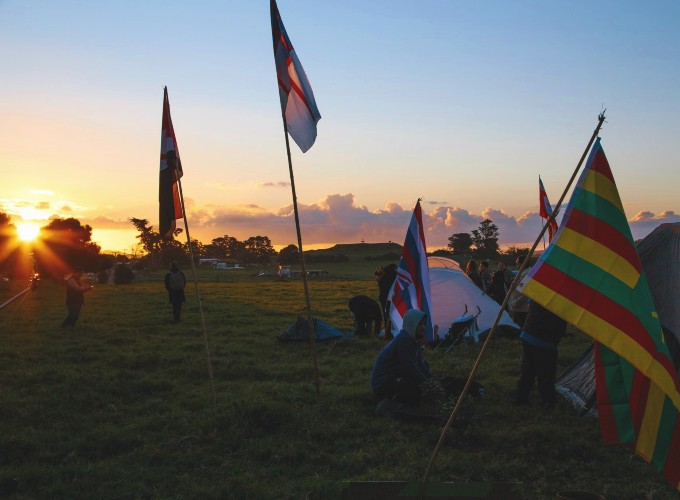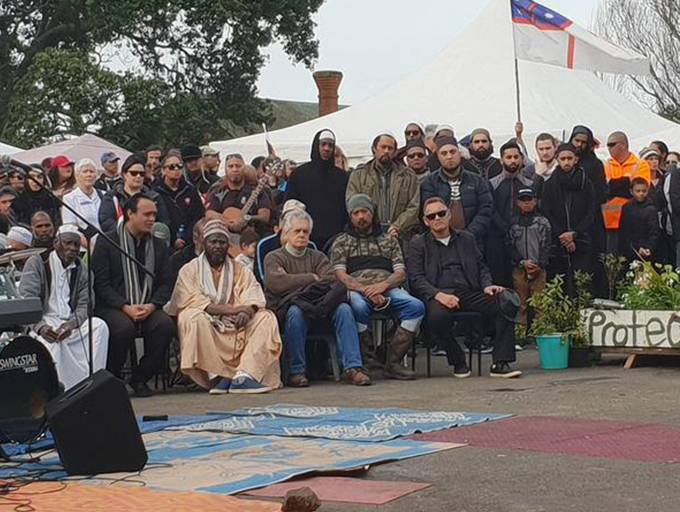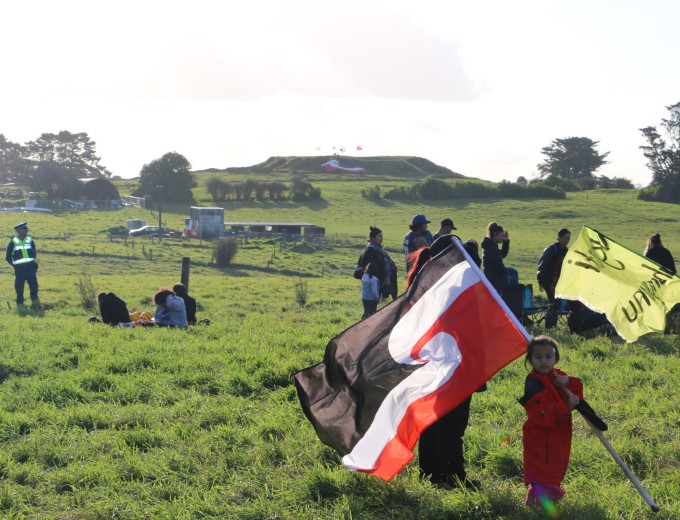
By Michael Andrew
AUCKLAND (Asia Pacific Report/Pacific Media Watch): The occupation at Ihumātao is a spectacle of flags.
In every direction they flutter. Alongside tino rangatiratanga – the Māori flag of independence, Samoan colours fly. Next to the United Tribes of New Zealand banner a Tongan flag quivers. A Niuean flag stands tall on Te Puketaapapatanga ā Hape – the sacred Maunga. A Hawai’ian flag is draped from the shoulders of a man like a cape. And on a teenager’s black t-shirt the Morning Star, the true flag of the people of West Papua is displayed with proud impunity.
It’s the Pacific, come ashore at Ihumātao, standing alongside tangata whenua with whom past, present and future are bound through ancestral bloodlines and an ocean of perspective.
GALLERY: Guardianship photo shoot with the Ihumātao ‘protectors’ – Del Abcede
WATCH Pacific people rally behind Ihumātao occupation – Tagata Pasifika
Yet here at Ihumātao, the site of a peaceful occupation to protect sacred Māori land from development, the flags are more than symbols of national identity. Here they are united symbols of indigenous.
As one supporter was reported declaring: “This is an indigenous problem!”
Although this occupation, against a backdrop of colonial injustice, means so much for Māori in Aotearoa and indigenous across the Pacific who are facing similar battles to protect their land, it has also mustered the support of other cultural groups whose members have formed their own deep and unique connections with Māori people and culture.
Asian presence at Ihumātao
If presence – both at the occupation site and on social media – is anything to go by, one of the most ardent non-Māori supporters of the occupation is Asians Supporting Tino Rangatiratanga.
Formed in 2016 from a group of six Asian-New Zealanders, ASTR now has a chapter in both Auckland and Wellington and thousands of supporters from across the country.
The members are passionate in their support of the Mana Whenua at Ihumātao, and were part of the Asian delegation at the occupation.
Outside of protests, they organise Te Tiriti o Waitangi (the Treat of Waitangi) workshops where other Asian migrants can learn about the Treaty and Aotearoa’s colonial history.
“We’re trying to demystify [the history] and build bridges,” says youth worker and ASTR member Mengzhu Fu.
![Asians Supporting Tino Rangatiratanga … “We’re trying to demystify [the history] and build bridges.” Image: Asians Supporting Tino Rangatiratanga/Facebook](../sites/default/files/inline-images/ASTR%20680w%20130819_0.jpg)
A 1.5-generation Chinese New Zealander, she says many Asian migrants have been fed a Pākehā narrative about Māori when arriving here. Naturally, this has created a division between the groups.
“Pākehā try and mediate the relationship between Asians migrants and Māori,” she says.
The colonial status quo
“When they have control of those relationships they often pit migrants against Māori and that division often works in their favour to maintain the colonial status quo.
“The relationship often has to be through them but we want to bypass them and directly build those relationships.”
She also says because of language issues Asian migrants are often susceptible to the misrepresentation precipitated through the New Zealand media.
“There’s is a lot of misinformation that is translated from Pākehā media.
“A lot of our communities that are not as fluent in English will receive that media and make a perception of Māori based on Pākehā translations.”
While she was certainly exposed to those negative perceptions when she first arrived here as a child, she has since discovered that the reality is far different.
Journey of discovery
Her journey however has been her own, and like many New Zealanders, her high school years did little to expose her to much of this country’s history.
“I went to quite a prestigious public school and I only remember learning about the Treaty in fourth form and it was quite brushed over.
“We did re-enactments of the Treaty but we never learned what happened after it was signed.”
Another member of ASTR, Qian-ye Lin, agrees: “I think I only learned about the Treaty or specificity of New Zealand colonial history through my friends, like by falling into friend groups that are political and who are willing to teach me.”
Also a migrant from China, Lin says that Asian migrants are desperate to integrate into Pākehā society which means that the Māori world often falls into the shadows.
“There is this massive need to assimilate whether it is for survival or otherwise.
“That was my journey of assimilating into the Pākehā world and then realising that by doing that I’m also complicit in colonisation.”
Cultural reflections
A student at the University of Auckland, Lin says that one of the most valuable aspects of learning about New Zealand’s colonial injustices is the insights it provides her into her own culture.
“I feel that being Han Chinese and of the more privileged class I’ve definitely been quite blind to colonisation or the perspective of indigenous people because I do occupy the space of being the dominant majority in China.”
She says that ASTR’s work helps educate Asian migrants and enables them to engage meaningfully with the colonial aspects of their own ancestry.
However, both her and Fu hope the work will also permeate more into Pākehā society.
“Sometimes it’s as simple as listening. Listening to people who have been disempowered,” Fu says.
Lin agrees: “I feel like the first step is to get over your fragility, and being brave enough to admit that maybe you do occupy a dominant position.”
“It’s about taking accountability and realising that Pākehā have been privileged because of that history and there are ways that they can dismantle that as well.”
Muslim delegation
On a weekend in late July, a Muslim delegation was welcomed with a pōwhiri onto the whenua at Ihumātao.
They sat with the kaumatua (elders), listened to karakia (prayer) and waiata (songs) and were shown hospitality in accordance with the revered Māori customs of manaakitanga.
Among the delegation – which included several Islamic leaders and scholars, was Shaymaa Arif who has found that the principals of manaakitanga have an uncanny similarity to Islamic customs.
It’s the respect and inclusivity of manaakitanga, she says that is bringing Māori and New Zealand Muslims closer together.
“An understanding has really developed,” she says.
“The communities are becoming closer to each other, the gap is becoming smaller.”

A former human rights lawyer based in Kirikiriroa (Hamilton), Arif says the contact between Muslims and Māori has historically been stifled by fear based on media-driven stereotypes and intergenerational ignorance.
A bond is forming
However, in recent years the walls have started to come down and a true bond is forming, the kind that can only form between people who have shed similar tears and felt similar pain.
“There is a long trail of tears in this beautiful country which we as people from minority groups have also experienced on a different level so we understand the struggle.”
After the Christchurch mosque attacks on March 15, that understanding was galvanised into something even stronger.
“The Māori community stood with us so much. They came out and gave us that space to lean on them.”
“They literally were like ‘we understand the struggle. We’ve been through this for so many years.’”
For Arif, who has ventured up from Hamilton three times to join the occupation, the kindness and support shown to her by Māori deeply affected her youth. In her teen years she was included in kapa haka groups without question. In her university years Māori mentors coached her even through she’s not Māori. It was manaakitanga she says, that made her feel connected and welcome.
And yet now, four months after the mosque attacks, questions are being asked if that sense of public connection and unity that was touted on a national level in the aftermath of March 15 has been maintained. Has the bulk of New Zealand society moved on, and once again forgotten about its Muslim community?
Possibly, but certainly not by everyone. Arif says that every Friday evening, four months on from the attack, a group of local Māori pitch a gazebo on the park across the road from the Hamilton mosque and stand guard, while inside the worshippers pray in peace.
That, she says, is why she stands with the mana whenua at Ihumātao.




